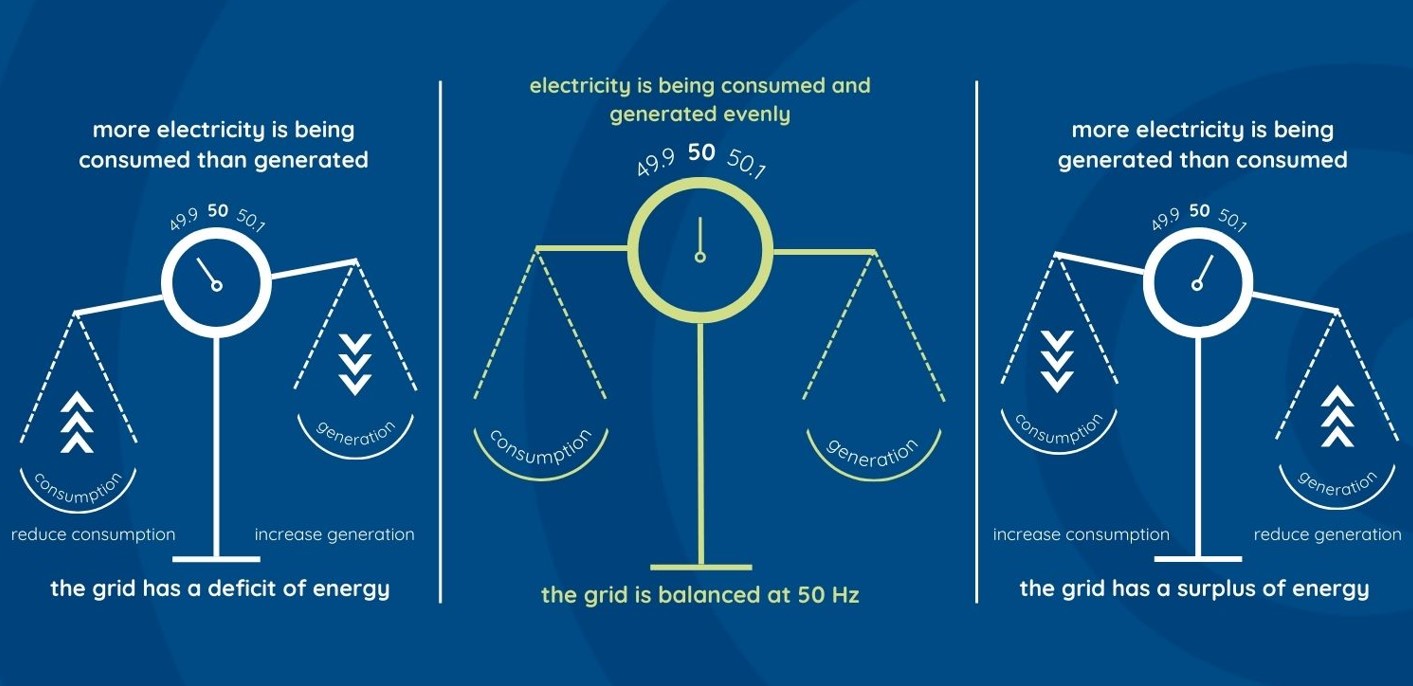Maintaining grid balance
The stability of our power grid hinges on maintaining a balanced frequency. To ensure this, we need certain support functions, so-called ancillary services. These include:
- Frequency regulation: matching supply and demand scenarios in (close to) real-time
- Voltage control: stabilization of grid voltage levels within safe and operational limits.
- Spinning reserves: immediately available backup power actively synchronized with the grid.
- Non-spinning reserves: offline backup power available within a short time frame.
- Redispatch: real-time adjustment of electricity generation and absorption of individual power plants
- Black start: the ability to restore the grid after a complete shutdown, using power plants or generators that can initiate operation independently of the main grid.
What constitutes grid balance?
The grid is considered balanced when electricity is being consumed and generated evenly to reach a steady frequency of 50 Hz. It is the responsibility of the TSO (Transmission System Operator) to secure this balance, but fluctuations will inevitably happen. The grid can go out of balance in two ways.
- It can have a deficit of energy, which means more electricity is being consumed than generated, causing the nominal frequency to drop below 50 Hz.
- It can have a surplus of energy, which means more electricity is being generated than consumed, causing the nominal frequency to rise above 50 Hz.
To counter the first scenario, the TSO must see to it that consumption is reduced or that generation is increased. Inversely, the second scenario calls for an increase in consumption or a decrease in generation. The transactions to achieve this 50 Hz balance occur in various markets, where the TSO procures energy products from participants who trade energy to capture value.

For asset optimization, frequency regulation holds the most opportunities, most notably the control reserve markets, including FCR (Frequency Containment Reserve), aFRR (automatic Frequency Restoration Reserve), and mFRR (manual Frequency Restoration Reserve). In these, the TSO procures reserves to have enough capacity available for activation in the event of a grid imbalance. FCR is the primary reserve, aFRR the secondary reserve, and mFRR the tertiary reserve. This gives the TSO the constant security of a backup reserve. For example, if both the FCR and aFRR reserves are maxed out due to the outage of a big power plant and struggle to handle other fluctuations and imbalances that continue to happen, the mFRR reserve can still be activated manually to provide grid relief and maintain stability.
The exact timeframes in which such balancing transactions occur are expressed in D units, where D stands for delivery day, D-1 for delivery day minus one, D-7 for delivery day minus 7, and so on. The table below gives you an overview of the most important features of FCR, aFRR, and mFRR, using the common internal markets as reference.
| |
FCR |
aFRR capacity |
aFRR energy |
mFRR capacity |
mFRR energy |
| Hierarchy |
primary reserve |
secondary reserve |
secondary reserve |
tertiary reserve |
tertiary reserve |
| Purpose |
- responding quickly to grid imbalances
- limiting frequency deviations
|
- freeing up exhausted FCR reserves
- restoring system frequency
|
- freeing up exhausted FCR reserves
- restoring system frequency
|
- freeing up exhausted aFRR reserves
- restoring system frequency
|
- freeing up exhausted aFRR reserves
- restoring system frequency
|
| Procurement |
local and cross-border |
local and cross-border |
local and cross-border |
local and cross-border |
local and cross-border |
| Bid submission |
11 am D-14 to 8 am D-1 |
9 am D-7 to 9 am D-1 |
up until 25 minutes before each delivery period |
10 am D-7 to 10 am D-1 |
up until 25 minutes before each delivery period |
| Product duration |
4 hours |
4 hours |
15 minutes |
4 hours |
15 minutes |
| Activation method |
automated based on frequency deviations |
automated based on TSO signal |
automated based on TSO signal |
manual |
manual |
| Pricing system |
pay-as-cleared |
pay-as-bid |
pay-as-cleared and sometimes pay-as-bid |
pay-as-bid |
pay-as-cleared and sometimes pay-as-bid |
| Common internal market |
FCR Cooperation |
|
PICASSO* |
|
MARI* |
| Operational member countries |
AT, BE, CZ, DK, NL, FR, DE, SI, CH |
|
AT, CZ, DE, IT |
|
AT, CZ, DE, IT |
*PICASSO: Platform for the International Coordination of Automated Frequency Restoration and Stable System Operation
*MARI: Manually Activated Reserves Initiative
To sum up, the stability of our grid hinges on a multi-tiered, inter-supportive system of ancillary services. The hierarchical structure of the primary, secondary, and tertiary reserves ensures the sufficient availability of backup power to manage unexpected grid disturbances and provide consistent security of supply. Check here to get a more in-depth understanding of the market design and participation in the individual markets.
In battery monetization, a cross-market optimization approach is key to securing maximum profitability. Are you interested in leveraging ancillary services with your asset?
Let’s talk about your project →
